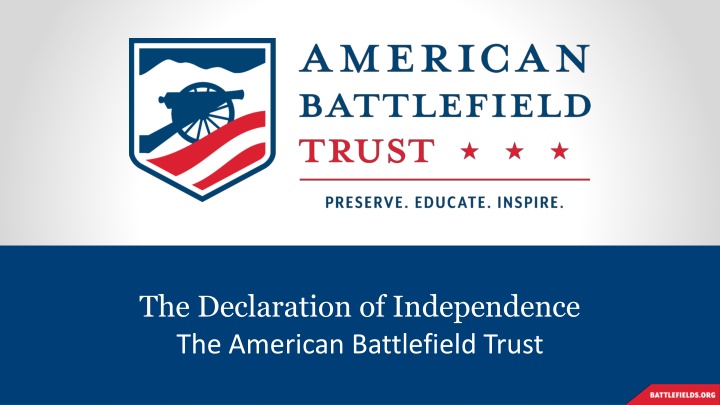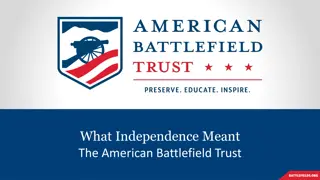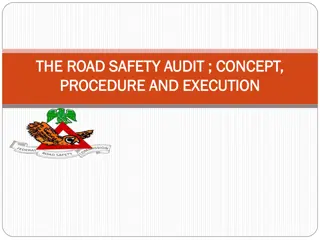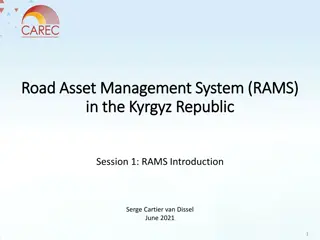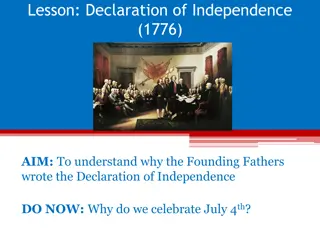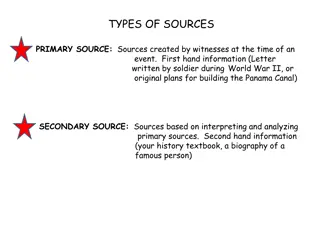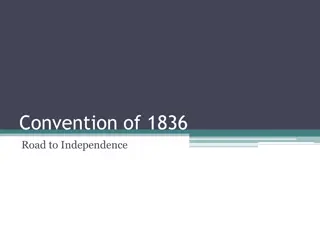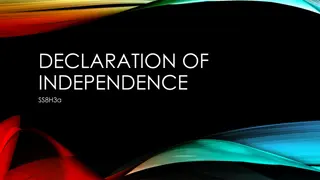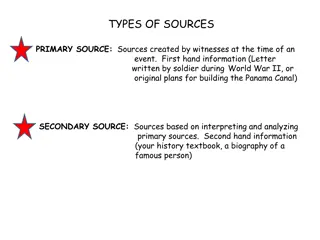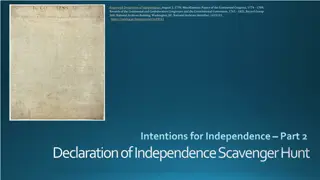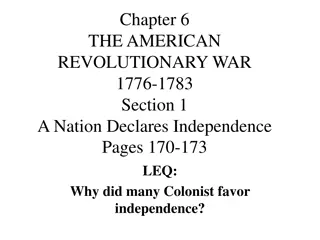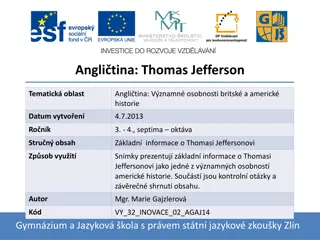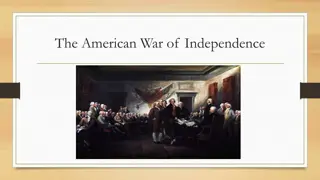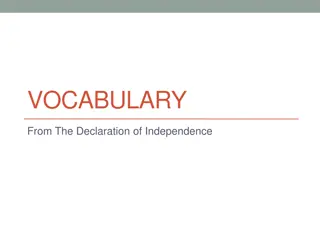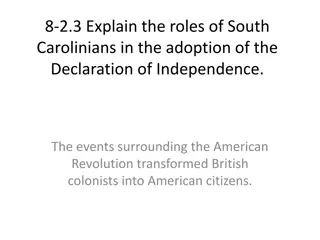Journey to Independence: The Road to the Declaration
Explore the pivotal events leading to the Declaration of Independence in 1776, including failed petitions, early declarations, and the drafting process. Learn about the reasons behind declaring independence and the key figures involved in shaping this historic document.
Download Presentation

Please find below an Image/Link to download the presentation.
The content on the website is provided AS IS for your information and personal use only. It may not be sold, licensed, or shared on other websites without obtaining consent from the author.If you encounter any issues during the download, it is possible that the publisher has removed the file from their server.
You are allowed to download the files provided on this website for personal or commercial use, subject to the condition that they are used lawfully. All files are the property of their respective owners.
The content on the website is provided AS IS for your information and personal use only. It may not be sold, licensed, or shared on other websites without obtaining consent from the author.
E N D
Presentation Transcript
The Declaration of Independence The American Battlefield Trust
Essential Question What were the reasons for the Declaration of Independence as presented in the document and 1776 discussions about it?
The failed Olive Branch petition meant that the colonists were declared to be in "open and avowed rebellion." So, the delegates began to think independence was inevitable. Context: 1774-1776 British blockade of Boston harbor made the other colonies feel the need to enact reactionary measures However, the Continental Congress did not have the authority to declare independence without the permission of the individual colonial governments. The Continental Congress then began to look to individual colonial governments to give permission to their delegates to vote for independence. North Carolina first, Virginia second
Multiple Declarations? The Mecklenburg Declaration of Independence was allegedly signed on May 20, 1775 The original document was supposedly destroyed in a fire in 1800. Some modern scholars do not consider the Mecklenburg Declaration to be legitimate. However, they could have been a part of the Mecklenburg Resolves that were created just eleven days following the supposed signing of the pseudo- declaration on May 31, 1775. "We the citizens of Mecklenburg county, do hereby dissolve the political bands which have connected us to the Mother Country"
Early Declarations Lee Resolution The Virginia Declaration of Rights "A Declaration of Rights Is made by the representatives of the good people of Virginia, assembled in full and free convention which rights do pertain to them and their posterity, as the basis and foundation of government." "These United Colonies are... free and independent States... [and] are absolved from all allegiance to the British Crown, and that all political connection between them and the State of Great Britain is... dissolved." November 7, 1765 June 7, 1776
Committee of Five Thomas Jefferson, John Adams, Benjamin Franklin, Roger Sherman and Robert R. Livingston Consulted about the outline of the declaration and determined that Thomas Jefferson should write the first draft. On June 11, 1776, Jefferson began to write his version
The Declaration of Independence July 4, 1776 On June 28, after making some changes as a group, the Committee of Five presented Jefferson s version of the declaration to Congress. Congressional changes including: Removing a clause blaming King George III for the slave trade in the colonies. Intended for a wide audience
Final Declaration Structure Preamble Second section Third section Outlined the rights of man and the right for the colonists to fight for their cause. The words of the preamble were meant to unite Americans under a realization that the future could be brighter if they continued to fight. Outlined the grievances against King George III to remind everyone of the tyranny that the King exercised over the colonists and thereby justify their fighting. Declared the thirteen colonies as free and independent states.
Revolutionary Consequences Before the declaration, the war was for representation in Parliament, not entire independence "SOS" call to other nations French involvement increased France had been secretly sending weapons since early 1776 Declaration showed France that the U.S.A. was committed to victory What different purposes did the declaration serve?
Washington Presents the Declaration In Manhattan, on July 9, 1776, George Washington announced a gathering in so he could present the Declaration of Independence. Gave a short speech first, then read the declaration "The Honorable the Continental Congress, impelled by the dictates of duty, policy and necessity, having been pleased to dissolve the Connection which subsisted between this Country, and Great Britain, and to declare the United Colonies of North America, free and independent STATES."
"The General hopes this important Event will serve as a fresh incentive to every officer, and soldier, to act with Fidelity and Courage, as knowing that now the peace and safety of his Country depends (under God) solely on the success of our arms." Effect on Morale Washington hoped it would increase motivation among soldiers Mob attacked a statue of King George III
John Adams On Committee of Five July 3, 1776, letter "It will be celebrated, by succeeding Generations, as the great anniversary Festival" Abigail Adams "Remember the Ladies"
Notable People John Hancock Robert Morris Benjamin Rush
Aftermath Independence, of course, hit Loyalists the hardest Many never believed the British would abandon them by acquiescing in a peace they had forsaken their homes and safety to prevent. The announcement of peace in New York City was met with stunned disbelief. New meaning for the war Don Troiani
War for Independence The war continued for another seven years Declaration gave it a new, specific purpose and encouraged foreign involvement Don Troiani
Special Thanks Thank you to historical artist Don Troiani for allowing American Battlefield Trust to share his artwork for educational purposes. In the order that they appeared in this PowerPoint: "Wife gives soldier husband his sword" (Slide 15) "Returning Continental Soldier" (Slide 16)
